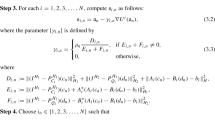Summary
Finding bounding sets to solutions to systems of algebraic equations with uncertainties in the coefficients, as well as rapidly but rigorously locating all solutions to nonlinear systems or global optimization problems, involves bounding the solution sets to systems of equations with wide interval coefficients. In many cases, singular systems are admitted within the intervals of uncertainty of the coefficients, leading to unbounded solution sets with more than one disconnected component. This, combined with the fact that computing exact bounds on the solution set is NP-hard, limits the range of techniques available for bounding the solution sets for such systems. However, the componentwise nature and other properties make the interval Gauss–Seidel method suited to computing meaningful bounds in a predictable amount of computing time. For this reason, we focus on the interval Gauss–Seidel method. In particular, we study and compare various preconditioning techniques we have developed over the years but not fully investigated, comparing the results. Based on a study of the preconditioners in detail on some simple, specially–designed small systems, we propose two heuristic algorithms, then study the behavior of the preconditioners on some larger, randomly generated systems, as well as a small selection of systems from the Matrix Market collection.
Similar content being viewed by others
References
Alefeld, G., Kreinovich, V., Mayer, G.: The shape of the symmetric solution set. In: Kearfott, R. B. and Kreinovich, V. (eds.) Applications of interval computations: Papers presented at an international workshop in El Paso, TX, February 23–25, 1995. Applied Optimization, vol. 3, Norwell, MA, pp. 61–80. Kluwer, Dordrecht (1996)
Alefeld G., Kreinovich V. and Mayer G. (2003). On the solution sets of particular classes of linear interval systems. J Comput Appl Math 152: 1–15
Boisvert R.F., Pozo R., Remington K., Barrett R. and Dongarra J.J. (1997). The Matrix Market: a web resource for test matrix collections. In: Boisvert, R.F. (eds) Quality of numerical software, assessment and enhancement, pp 125–137. Chapman and Hall, London
Gau, C.-Y., Stadtherr, M. A.: Reliable high-performance computing strategies for chemical process modelling. (1999) http://www.nd.edu/~markst/dallas99/slides213c.pdf
Hu, C.-Y.: Splitting preconditioners for the interval Newton method. Ph.D thesis, University of Southwestern Louisiana (1990)
Hu, C.-Y., Kearfott, R.B.: A pivoting scheme for the interval Gauss–Seidel method: Numerical experiments. In: Approximation, optimization and computing: Theory and applications, pp. 97–100. Elsevier, Amsterdam (1990)
Kearfott R.B. (1990). Preconditioners for the interval Gauss–Seidel method. SIAM J Numer Anal 27: 804–822
Kearfott R.B. (1996). Rigorous global search: continuous problems. Kluwer, Dordrecht
Kearfott, R. B., Hongthong, S.: On preconditioners and splitting in the interval Gauss–Seidel method. Tech. report, University of Louisiana at Lafayette (2005) http://interval.louisiana.edu/preprints/2005_new_S_preconditioner.as_submitted.pdf
Kreinovich V., Lakeyev A., Rohn J. and Kahl P. (1998). Computational complexity and feasibility of data processing and interval computations. Kluwer, Dordrecht
Leyffer S., Lopez-Calva G. and Nocedal J. (2006). Interior methods for mathematical programs with complementarity constraints. SIAM J Optim 17: 52–77
Muhanna R.L. and Mullen R.L. (2001). Uncertainty in mechanics problems. J Eng Mech 127: 557–566
Neumaier A. (1990). Interval methods for systems of equations. Cambridge University Press, Cambridge
Neumaier A. and Pownuk A. (2007). Linear systems with large uncertainties, with applications to truss structures. Reliable Comput 13: 149–172
Novoa, M.: Theory of preconditioners for the interval Gauss-Seidel method and existence/uniqueness theory with interval newton methods. Tech. report, Deptartment of Mathematics, University of Southwestern Louisiana (1993)
Oettli W. (1965). On the solution set of a linear system with inaccurate coefficients. SIAM J Numer Anal 2: 115–118
Oettli W. and Prager W. (1964). Compatibility of approximate solution of linear equations with given error bounds for coefficients and right-hand sides. Numer Math 6: 405–409
Pryce J.D. and Corliss G.F. (2006). Interval arithmetic with containment sets. Computing 78: 251–276
Rohn J.: Solving systems of linear interval equations. In: Reliability in computing, perspectives in computing, pp. 171–182 Academic Press, New York (1988)
Rump, S. M.: INTLAB – INTerval LABoratory (INTLAB home page) (2005) http://www.ti3.tu-harburg.de/~rump/intlab/
Author information
Authors and Affiliations
Corresponding author
Rights and permissions
About this article
Cite this article
Kearfott, R.B. A comparison of some methods for bounding connected and disconnected solution sets of interval linear systems. Computing 82, 77–102 (2008). https://doi.org/10.1007/s00607-008-0258-2
Received:
Accepted:
Published:
Issue Date:
DOI: https://doi.org/10.1007/s00607-008-0258-2




